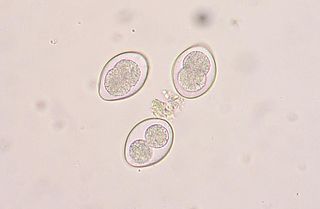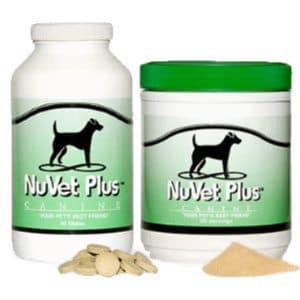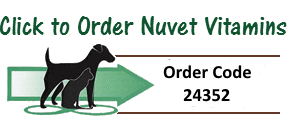Coccidiosis in Dogs
by Janice Jones |Last Updated 06-29-2021
Coccidiosis in dogs is a contagious infection that affects puppies, dogs and other animals. This medical term is given to a dog or puppy that has Coccidia in their intestinal tract. Coccidia are tiny one celled organisms that belong to the protozoan group of animals. Often mistaken for worms, they are the most common protozoan infections in North America.
In fact, according to the Companion Animal Parasite Council’s published survey indicate that it is present in from 3% to 38% of dogs.
About Coccidiosis in Dogs
Table of Contents
In this article, I will discuss the following topics. Feel free to jump around or scroll down to read the entire article.
Good News - Bad News About Coccidiosis in Dogs
Life Cycle of the Coccidia Organism
Good News ~ Bad News About Coccidia
This organism affect many different animals including dogs but all are species specific meaning that those Coccidia that inhabit the intestinal tracts of dogs are different from those that dwell in cats and other animals. And now for the good and bad news:
The good news is humans cannot get the Coccidiosis infection that dogs get. The most common form of coccidia in dogs is Isospora canis but there are other species that have also been identified including I. ohioensis, I. neorivolta, and I. burrowsi.
The bad news is that they can be dangerous in young puppies and debilitated adults or those with weakened immune systems.
One problem with Coccidia is that it tends to multiply rapidly causing cells in the intestinal wall to rupture thus causing damage to the intestinal wall.
The other problem with these one-celled organism is that they are extremely resistant to environmental conditions and almost completely impossible to remove from the environment entirely.
Many dogs may be infected with coccidia and have built up an immunity to it over time. Since these dogs do not show any symptoms, these types of infections are callded sub-clinical but the dog can still pass the coccidia in their stool.
How Did My Puppy Get Coccidiosis?
These protozoans are passed in the feces of one animal and can contaminate food and water sources. Then they are ingested by other animals and start their life cycle all over again in the new host.
In other words, puppies that eat contaminated soil, grass or poop can become infected. Another very easy way that puppies become infected is to walk through soil, grass, or poop and then walk on their food or chew toy.
Remember that very young puppies are just like toddlers learning to walk; they get excited and forget what they are doing. In their excitement a puppy could walk on some poop, then jump into its water bowl, maybe lick their paw, remember it was thirsty and take a drink. Yikes! He just infected himself.
Just in case you are interested in the life cycle of these little pests, the next section will describe it briefly. Feel free to skip it if you are just interested in symptoms and treatment.
Life cycle
The life cycle of the Coccidia is quite complicated. The dog or puppy becomes infected when it ingests “oocysts” that have been passed in the feces of another dog. The oocyst or immature form of the parasite is excreted in the feces and may remain dormant on the ground, in the soil, or in standing water. Under ideal temperature and humidity, these oocytes sporulate and become infective.
If a puppy or susceptible adult dog eats the soil or fecal matter where these newly sporulated oocysts are living, the parasites release a generation of sporozoites that invade the lining of the intestines. From here little sporozoites embed themselves into the small intestines and reproduce.
Each new generation invades other cells causing massive destruction of the cells in the small intestine. new oocytes form and are then passed through the body and out in the feces. At this point, the oocyte is not infected.
Once liberated from the host’s body, though it can become infective under the right environmental conditions, and if swallowed by a new host, begins its lifecycle all over again.
These oocytes are resistant to adverse environmental conditions and can survive as long as one year in moist, protected environments if they are not exposed to freezing or extremely high temperatures.
The incubation period or time between exposure and symptoms appearing is about 2 weeks.
Symptoms
- Foul Smelling Diarrhea, with or without mucus or blood
- Vomiting sometimes
- Dehydration
- Loss of appetite
As mentioned before, t is not uncommon for adult dogs to carry the protozoan in their intestinal tracts without ever showing signs of the disease. If the oocytes are found in the stool of a dog without diarrhea, they are generally considered transient, and are not treated.
Most adults who have come in contact with Coccidia at some point in their life have built up personal immunity. Even though the adult dog doesn’t show any symptoms, they can still infect others.
Consider this Common Scenario...
A mother dog who is not showing any signs of the disease still passes occasional oocysts in her stool. The puppiesmay come in contact with the mother's stool or other adults living in the same location. The puppies ingest the oocytes and become infected. Stress is usually the way symptoms appear. This process often occurs during the period when new puppies go to their forever homes. The transition is stressful and symptoms of diarrhea and possible vomiting occur.
But going home for the first time is not the only thing that could cause symptoms to occur. Anything that is stressful to puppies can bring it on even changes in weather, travel, new people, a new family member, you name it.
Coccidiosis is frequently referred to as an opportunist disease. The highest incidence of Coccidiosis is found in dogs and puppies in the first 21 days after having changed owners and moved to a new home.
A good rule of thumb to consider is if your new puppy shows signs of diarrhea within the first 2 weeks of coming home, he probably became infected at the breeder’s home.
If it has been more than two weeks, it might indicate that he contracted the disease from your property or a place where he has been, either on a walk in the park, a neighbor or friend’s house, or any other place where he might have come in contact with contaminated ground.
In mild cases, you might not see any symptoms, but usually diarrhea is the most common indicator that something is happening. Diarrhea can also contain mucus and even blood. Any fecal matter that is extremely foul smelling will contain blood, even if it is not visible to the the naked eye. Stools with blood and this containing blood can cause the puppy to become dehydrated. Loss of appetite, weight loss, lack of energy and vomiting are also common.
In very severe cases the nervous system can be affected and the puppy might have muscle tremors, and convulsions. Death can occur in very severe cases that have not been treated but the majority of cases can be treated easily and successfully.
If a puppy is showing any of these signs it is vital that you get to your veterinarian as soon as possible because these same symptoms can show up in Parvo Virus, an extreme dangerous if not fatal illness.
How is Coccidiosis Diagnosed?
There are two ways that veterinarians diagnose the disease. One way is a positive stool sample and the other way is by the clinical symptoms. Veterinary clinics will request a fecal sample, prepare it and view it under a microscope for the presence of cells.
It is likely that a negative stool sample cannot rule out the possibility of Coccidia because the Coccidia may not be shed in every stool sample. Your vet may also rule out the possibility of Parvo. If a new puppy presents to the veterinarian with symptoms of diarrhea, anorexia (not eating) and the owner states that she just got the pup a week ago, it is a pretty good indication that the problem could be Coccidia.
How is Coccidiosis in Dogs Treated?
Coccidiosis is treated with drugs and supportive treatment such as fluids if necessary.
The most common drugs used are sulfadimethoxine as found in Albon®, Bactrovet® or Tribrissen®.
Albon® has a custard-like flavor that appears to be very pleasant for puppies but the downside is that it must be administered for 10 days. Albon® does not actually kill the Coccidia but rather interferes with the life cycle making it impossible for them to reproduce.
Once the Coccidia are under control, the host’s immune system takes over and cures the animal.
Newer treatments, such as the equine drug Ponazuril (Marquis) are gaining popularity to treat Coccidia, but are not currently licensed for use in dogs and cats.
Ponazuril® has the advantage of a shorter course of therapy because it actually kills the protozoan directly.
If your puppy has severe symptoms, sometimes additional treatments may be given such as fluids or hospitalization.
Sometimes the vet may prescribe probiotics or other mild digestive aids. Ask your vet if he/she does not mention these.
Probiotics helps to restore the normal microbial balance in the digestive tract. Introducing the "good" bacteria into the gut reduces inflamation and improves symptoms. Here are a couple of great products to try. Probiotics often come in powder form that you can sprinkle on your dog's food. Others, like the Probiotics for Dogs (pictured) come as a treat. All of the products listed can be purchased directly from Amazon.
DIgestive aids are also good for calming the intestinal tract and can be used for other digestive upsets.
Both of these types of products should be part of your dog's first aid kit. The product pictured is the one I use with my own dogs, but there are others out there that are equally good.

Treat the Environment
In addition to treating the dog, it is very important to treat the environment. Picking up the poop is only the first step but a very important step.
Using a good disinfectant is very important to eliminate even more of the threat. Disinfectants containing quaternary ammonium or bleach can be effective. Bleach should be diluted at one cup per gallon of water. These chemicals are good for areas that can be cleaned with them, but do not try to use them on a grassy area because it will kill the grass.
Household ammonia products can destroy oocysts, but you must remove the dog or puppy from the area so they are not affected by harmful odors.Another method that is highly effective is cleaning at high temperatures with steam cleaners or boiling water.
Clean all of your puppy’s toys in very hot or boiling water or place in the dishwasher. All blankets and bedding should be washed with bleach using hot water.
Remember to restrict access to cleaned area until the floor is completely dry.
Prevention
There is a good chance that your puppy will have built up some resistence, but there is no guarantee. Here are a couple of common-sense ways to keep your puppy healthy and your environment clean.
- Bathe the dog to be sure there is no fecal matter on his hair.
- Wipe off paws when dog returns to the house
- Remove feces immediately
- Discourage puppies from eating poop (coprophagia)
- Provide a high quality diet
- Keep water bowls clean and provide fresh clean water
"Hi, I'm Janice Jones, a former veterinary technician and Shih Tzu expert with over 40 years of experience with the breed. Through Miracle Shih Tzu, I combine my medical background and extensive breed knowledge to provide reliable, practical advice for Shih Tzu owners. My mission is to help you give your Shih Tzu the happiest, healthiest life possible through evidence-based information and real-world solutions. Whether you're new to the breed or a seasoned owner, you'll find trusted guidance here for all aspects of Shih Tzu care.
I hold an undergraduate degree in Psychology with a minor in biology, Early Childhood Education, and Nursing, and a Master's in Mental Health Counseling.




